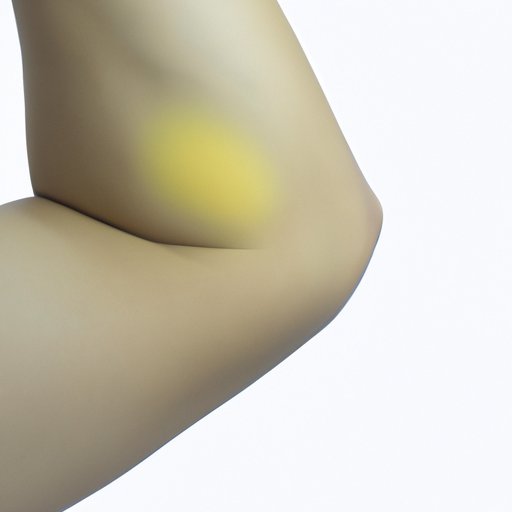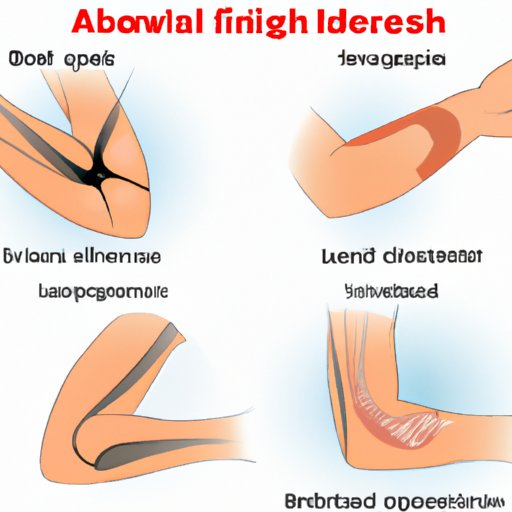
Introduction
The elbow joint is an essential aspect of the upper extremity, connecting the upper arm bone to the forearm bones. It allows rotational movements and arm extension and flexion. Due to its importance in everyday activities, the elbow joint is susceptible to injury.
In this article, we will explore elbow injuries, understanding what causes them, how to recognize the symptoms, and ways to prevent them. Additionally, we will take a look at the different types of elbow injuries and the treatment options you can expect from healthcare professionals. Lastly, we will provide you with some helpful tips to stay injury-free while keeping your elbow joint healthy.
The Anatomy of the Elbow: Understanding How Injuries Happen
The elbow joint consists of bones, cartilage, ligaments, and tendons, which work together to provide structural support and movement. The humerus, ulna, and radius are the three bones that form the elbow joint. The end of the humerus connects with the ulna and radius to form the elbow joint. The elbow joint contains cartilage that helps in joint movement.
Several activities can cause elbow injuries, including falls, overuse, and direct impacts. The most common elbow injuries include radial head fractures, elbow dislocations, and olecranon fractures.
Radial Head Fractures
A radial head fracture typically occurs due to direct trauma to the elbow, such as falling on an outstretched arm. It is the most common type of elbow fracture, accounting for a majority of all elbow fractures.
Elbow Dislocations
Elbow dislocations may result from falls, car accidents, or direct trauma to the elbow. It is a rare type of elbow injury that may cause significant damage to the bones and surrounding soft tissues.
Olecranon Fractures
Olecranon fractures occur when you fall directly onto your elbow, leading to a break in the olecranon. An olecranon fracture can be a severe injury that may require surgical intervention.
When a Simple Fall Can Cause a Broken Elbow: Knowing the Symptoms
Identifying an elbow injury can be challenging because several different injuries have similar symptoms. In case of any elbow discomfort, it is important to seek medical attention as soon as possible to determine the extent of the injury.
Symptoms of a Broken Elbow
The typical symptoms of a broken elbow are:
- Pain
- Swelling
- Bruising
- Tenderness
- Decreased range of motion
Differentiating between Elbow Injuries and Other Types of Injuries (e.g. Sprains)
Elbow injuries may have similar symptoms to other injuries, such as sprains. However, some key differences can help to differentiate between these injuries. For instance, a sprain may cause pain and swelling around the joint, but a fracture may also cause bony deformity around the joint. Additionally, if the elbow has been dislocated, a visible deformity may be present.
When to See a Doctor for Elbow Pain or Discomfort
If you experience significant pain or discomfort in your elbow or have difficulty with movement, it is important to see your doctor promptly. Neglecting an injury can result in further damage or complications.
5 Surprising Ways You Can Break Your Elbow and How to Avoid Them
Many everyday activities can lead to elbow injuries. Knowing what these activities are and how to avoid them is essential to prevent elbow injuries.
Common Activities that Can Lead to Elbow Injuries
Five surprising activities that can lead to elbow injuries are:
- Using heavy machinery without proper arm support
- Playing racket sports with poor technique or gripping the racket too tightly
- Carrying heavy items for an extended period or carrying bags on one arm
- Working at a computer with poor posture
- Not using proper safety precautions when participating in activities such as motorcycle riding or skateboarding
Precautions and Safety Measures to Prevent Elbow Injuries (e.g., Protective Gear)
There are several ways to prevent elbow injuries, including:
- Wearing appropriate protective gear and equipment.
- Strengthening the muscles around the elbow with regular exercise and targeted workouts
- Maintaining proper posture during work and activities
- Using ergonomic equipment, such as computer keyboards and chairs.
- Focusing on proper form and technique when participating in physical activities.
Importance of Proper Technique and Form During Physical Activities
Proper technique and form when participating in physical activities can help to prevent elbow injuries. Some key tips to consider include:
- Focusing on proper body alignment and posture during the activity
- Wearing appropriate shoes with proper support
- Starting any physical activity slowly and increasing intensity gradually
- Enlisting a coach or trainer to guide you in the proper form and technique when starting a new sport or activity.

From Fractures to Dislocations: The Different Types of Elbow Injuries
Elbow injuries can range from mild to severe. Understanding the different types of elbow injuries can help you to recognize the symptoms and seek appropriate treatment promptly.
Overview of Different Types of Elbow Injuries
The different types of elbow injuries are:
- Fractures
- Dislocations
- Sprains and Strains
- Arthritis
- Tendinitis
Causes and Symptoms of Each Type of Elbow Injury
Each type of elbow injury has a unique set of causes and symptoms. Understanding these symptoms can help to differentiate between elbow injuries.
Fractures
The causes of elbow fractures include falls, direct impacts, and overuse. The symptoms of elbow fractures are pain, swelling, tenderness, and decreased range of motion.
Dislocations
Elbow dislocations may occur due to falls, car accidents, or direct impacts. The symptoms of elbow dislocations include visible deformation and severe pain and swelling.
Sprains and Strains
Sprains and strains are caused by overstretching or tearing of ligaments and tendons, respectively. The symptoms of sprains and strains include pain, swelling, tenderness and decreased range of motion.
Arthritis
Arthritis is a condition that affects the joints and can cause elbow pain and swelling. Symptoms of arthritis include decreased range of motion, tenderness, and stiffness.
Tendinitis
Tendinitis is a condition resulting from inflammation of the tendons in the elbow joint. Tendinitis is caused by repetitive activities that lead to overuse of the elbow joint. Symptoms of tendinitis include pain and swelling near the elbow joint.
Treatment Options for Each Type of Elbow Injury
Treatment for elbow injuries depends on the extent of the injury and the type of injury. Treatment options may include medication, physical therapy, or surgery.
Treating a Broken Elbow: What to Expect During the Healing Process
If you have broken your elbow, your healthcare provider will determine the best treatment option based on your injury’s severity. The treatment options for a broken elbow include surgery and non-surgery procedures.
How Broken Elbow is Treated (Surgery vs Non-surgery)
If the elbow is stable, non-surgical treatments may be appropriate, including bracing the joint and physical therapy exercises to regain strength and mobility. If the elbow is unstable or the fracture has spread, surgery may be required to regain proper function in the affected area.
Recovery Process and Rehabilitation Exercises
The recovery process for a broken elbow involves immobilizing the joint and may require physical therapy rehabilitation exercises to regain mobility and strengthen the surrounding muscles.
Tips for Managing Pain and Discomfort During Recovery
The tips to manage pain and discomfort during the recovery process for a broken elbow are:
- Taking prescribed medications to alleviate pain and discomfort.
- Using cold or warm compresses to reduce swelling and inflammation.
- Avoiding strenuous activities that may place additional strain on the healing joint.
Preventing Elbow Injuries: Tips for Staying Safe and Injury-Free
Preventing elbow injuries is crucial to maintaining joint health and function. Here are some tips to prevent elbow injuries:
Importance of Regular Exercise and Strengthening Exercises for the Elbow
Regular exercise and targeted workouts can help to strengthen the muscles surrounding the elbow and reduce the risk of injury. Incorporating cardiovascular and muscle-building exercises in your routine can improve joint health and overall well-being.
Tips to Prevent Overuse Injuries (e.g., Tennis Elbow)
Overuse injuries such as tennis elbow can be prevented by:
- Maintaining proper form and technique when performing repetitive movements
- Incorporating rest periods into your workout routine to avoid straining the joint
- Wearing proper protective gear during activities that may cause elbow strain
Importance of Nutrition and Hydration for Joint Health
Consuming a healthy, balanced diet and drinking adequate fluids can help to maintain joint health by providing necessary nutrients to the body. Consuming foods rich in vitamins and minerals such as calcium, vitamin D, and phosphorus can help to improve bone health and reduce the risk of fractures.
Living with a Broken Elbow: Coping Strategies for Everyday Life
A broken elbow can be challenging to manage, but some simple strategies can help you cope with everyday life on the road to recovery.
How to Continue Daily Activities with a Broken Elbow
Adapting to simple changes in your daily routine such as using your non-dominant hand for everyday tasks and avoiding activities that may place strain on the affected joint can help you to continue your daily activities with a broken elbow.
Coping Strategies for the Emotional and Psychological Impact of an Injury
An injury can take a toll on your emotional and psychological well-being. Coping strategies that can be helpful to cope with an injury include:
- Connecting with support groups or people going through similar situations
- Focusing on activities that can be performed despite the injury
- Consulting a therapist or counselor for additional support.
When to Return to Work or Physical Activities After a Broken Elbow
The time required to return to work or physical activities after a broken elbow depends on several factors, including the severity of the injury and the treatment option selected. It is essential to consult your healthcare provider before engaging in physical activity or returning to work.
Conclusion
Elbow injuries can be painful and debilitating, but with prompt medical attention, appropriate treatment, and preventive measures, they can be prevented. Understanding the different types of elbow injuries, the symptoms, and the treatment options available can help you approach elbow injuries with a proactive mindset. Always consult your healthcare provider if you’re experiencing pain or discomfort in your elbow as they can provide a diagnosis and an appropriate treatment plan.




